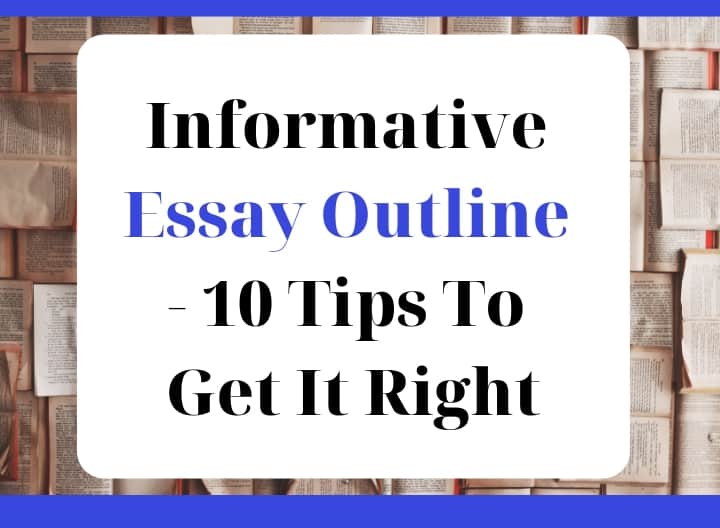
Writing an informative essay is so much easier if you first have a good outline in place.
In this article, I’ll show you what exactly is an outline, which elements it consists of, and how to write it to finish with a correctly formatted essay. Let’s do it!
Why do you need an outline in the first place?
A solid outline is your best insurance against writer’s block. The purpose of an outline is to put together the basic structure that will make your essay more organized. Once it’s completed, you can fill in the blanks with blocks of text and you’re done. I create an outline before I start any of my essays. In this way, I can envision the result from the very beginning. Another reason is that it helps you to bring some coherence to your thought process. This will result in a logical and organized sequence of ideas. Writing an outline is not mandatory, but it will make your life so much easier. So, let’s get straight to it.
How to write an informative essay outline
In this section, I’ll guide you through a step-by-step process of creating an outline. It’s best to learn by example, so after a quick explanation of each element, I provide a few samples that you can use as inspiration. Ready?
The main elements of an essay outline:
- Topic
- The introductory paragraph
- The lead (or “the hook”)
- The Thesis Statement
- The main points you’ll discuss in the essay (optional)
- The body paragraphs
- Idea 1 + Supporting research
- Idea 2 + Supporting research
- Idea 3 + Supporting research
- The conclusion paragraph
- Summary of the information provided and recommendations
- References and sources you use (optional)
A note about length: usually, an informative essay is 3-4 pages long (which is around 800-900 words). But it depends on your assignment, so ask your instructor to be sure.
The elements of an essay outline:
Mastering the Elements of Your Essay Outline
The Topic
Choose a topic that’s clear and enlightening. For instance, “The negative effects of alcohol use on the US population”. It sets the stage for what’s to come.
The Introductory Paragraph
Dive straight in but stay informative. Pull your reader into the essence of your essay, touching on your core idea and a few supporting nuggets. You’re setting the scene here.
The Lead (The Hook)
As most essay writers would concur, this is a tough cookie. It’s the sizzle that draws someone into an essay or any piece of writing. Capture the reader’s attention right from the get-go. Whether it’s a shocking fact, a relatable anecdote, or a poignant quote, make it memorable. For example, “88,000 deaths are annually attributed to excessive alcohol use.” (CDC)
The Thesis Statement
This is your anchor. A core statement, like “Alcohol is a leading cause of premature death in the USA.”, sets the direction. Your essay will revolve around supporting and proving this statement. Need more insight on this? Check out my piece on crafting stellar essays.
Main Points (Optional)
Briefly hint at the primary themes you’ll delve into. This isn’t a must, but it can guide your readers on what to expect.
Body Paragraphs
A standard essay boasts three body paragraphs, though you can push it to five if needed. Here, stay classic: present a main idea and back it up with cold, hard facts. For instance, you could say “Alcohol is the most abused harmful substance” and support it with a jarring statistic like, “In 2005, out of the 3.9 million Americans getting treatment for substance abuse, a whopping 2.5 million were battling alcohol.”
The Conclusion
Summarize without echoing your prior words. Close with impact, remembering that although it’s informative, your conclusion can still be captivating.
References (Optional)
List the resources that fueled your research. Whether they’re books, academic papers, or trusted online sources, they add credibility to your work.
Once you’ve sketched out your outline, dive into writing. For impeccable grammar and style, I vouch for Grammarly – it’s my go-to for all articles here. And if you’re grappling with assignments or prepping for a big test, consider the homework aid from the likes of Princeton Review.
An example of an informative essay outline
Now that you know all about the structure and formatting, let’s look at a short example so you can see how to create your very own outline. Title: “How regular cardiovascular exercise can help to treat depression” Introduction The lead (or “the hook”) – Here you would provide some dramatic statistics about depression: “It’s estimated that 16.2 million adults in the United States, or 6.7 percent of American adults, have had at least one major depressive episode in a given year.” The Thesis Statement – “Cardiovascular exercise is a highly effective, and safe long-term form of treatment for depression” The body paragraphs Idea 1 + Supporting research The link between exercise and depression according to the new research. Idea 2 + Supporting research The effects of exercise on mood in the long term (citing scientific data). Idea 3 + Supporting research Proven effects of exercise in depression treatment (including real-world examples). Conclusion Summary of the findings, restating the thesis, and the way forward.
One more outline example for your inspiration
Title: “The Advancement of Blockchain Technology in Today’s World” Introduction Here you would introduce the topic to a lay reader, and do your best to pique their interest. You could show a great way in which the new technology is already changing the world. The Thesis Statement – “In three to five years, blockchain technology will change the way the major industries operate in the world”. The body paragraphs Idea 1 + Supporting research How blockchain is already used by companies and government (supported by evidence). Idea 2 + Supporting research How blockchain already changed different industries and the way people do business around the world. Idea 3 + Supporting research The big changes coming in the future and different possibilities people need to consider. Conclusion Here you would give a bird’s-eye view of the situation and map out the way forward or give some sort of recommendation for the reader.
What is an informative essay?
When you get an academic assignment saying you should write an “informative essay”, you probably think to yourself – “phew, that’s way easier than other types of essays”. But don’t be so sure. An informative essay is a type of writing where you provide basic-level or in-depth information about any given topic. It’s written from a third-person perspective and aims to give an unbiased view of a subject. This usually means you’ll have to define a term, compare and contrast two phenomena, analyze data, share your conclusions, or simply describe how something is done. It can be assigned to you at any level of education. The broadness of this definition makes it hard to pinpoint the exact thing you should focus on. So make sure you consult your professor before building your outline to avoid re-works in the future.
Additional resources for your review:
- A Professor’s Guide to Writing Essays: The No-Nonsense Plan for Better Writing
- Premiere Essay Package (essay writing help and review)
- 20 Essay Writing Tips
- How To Write A Great Essay
It’s your turn to craft a perfect essay
I hope that after looking at all the information in this guide, you’ll be more than equipped to write a great informative essay that’ll earn you a high grade and bring you lots of satisfaction. If you just follow this formula, you simply can’t go wrong. You can even copy and paste the outlines provided here, and then just fill them out with your ideas. Next up, you may want to explore a guide on how to write a great expository essay.
Hey there, welcome to my blog! I'm a full-time entrepreneur building two companies, a digital marketer, and a content creator with 10+ years of experience. I started RafalReyzer.com to provide you with great tools and strategies you can use to become a proficient digital marketer and achieve freedom through online creativity. My site is a one-stop shop for digital marketers, and content enthusiasts who want to be independent, earn more money, and create beautiful things. Explore my journey here, and don't forget to get in touch if you need help with digital marketing.

